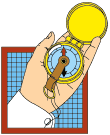Survival on a Ship

Part 6: Mapping and Navigation
Goals:
-
For the teacher to introduce mapping and navigation.
-
For the students to work effectively in groups of 4 to complete a mappingactivity.
Resources:
1. Maps for navigation
2. Maps for mapping activity
3. Treasure map reward pack
-The reward of pens, pencils and blow pops should be stapled shut
in a paper bag
-The reward should remain a mystery until the groups find their treasure
at the end of the
mapping activity.
Time Frame: Approximately 3 hours
Procedure:
1. The teacher will give a brief introduction to mapping and navigation.
2. The teacher will ask the students what they know about mapping
and navigation, and why it would be important for survival.
i.e.. -The teacher asks the student what they would do if they were
lost.
-Some possible answers might be asking for directions, look for street
signs, orfigure out
what direction they (North, South, East, or West) are facing.
- The teacher might then ask the class what they might do if they were
stranded inthe middle of the woods.
- Some possible answers might be to use the sun, stars, or compass
for direction.
3. If students have not covered all methods, teacher should explain why
it is important to know survival.
4. The teacher will provide examples of using mapping and navigation
to find distance and direction.
i.e. -The teacher asks the students to raise their hands if they know
directions and how they work.
-The teacher shows the class directions within the classroom--North,
South, East, West
-The teacher orally quizzes the class by pointing to a wall and asks
what direction it is.
5. The teacher will hand out a mapping and navigation assignment where
the students will find the distance
and direction from one point to other points on the map.
-The teacher demonstrates by drawing a map on the chalkboard (See
sample map).
6. The teacher will inform students to use what they know about finding
distances and directions through
mapping and navigation to construct a treasure map.
7. The groups will construct a treasure map that can only be solved by
finding correct distances
and directions (For example: To find the next clue, startfrom the
slide and go 30 paces West, then go 15 paces Southwest)
-The teacher must demonstrate to the students the proper way to measure
a pace.
-The teacher should remind the students that a pace is a regular stride
forward with your leg.
8. The students will execute the distances and directions on their group's
treasure map to check for accuracy (One group at a time should execute
their treasuremaps so their treasure is not discovered by another group)
Assessment:
-
Each group will assess the accuracy of their own treasure map (Criteriaforsuccess
= Each group will hand in a treasure map with accurate distances and directions)
-
Working effectively in groups (Criteria for success = all members of the
group contribute to the completion of the treasure map)
Possible Extensions:
-
Making the treasure map activity into a class competition, where the most
difficult, yet accurate, treasure map wins that group a prize.
Curricular Connections:
Math-- Calculating distances
Art-- The students will be creating and constructing their own map
as theydesire.
Go Back To "Survival on a Ship" Part 5: Using Library
Resources
Go To "Survival on a Ship" Part 7: Problem Solving
Go To Table of Contents
Survival developed by: David Didier, Justin Brandt, Travis Glandt,
and Steve Raethz for the St. Norbert College
Ocean Voyagers Program

